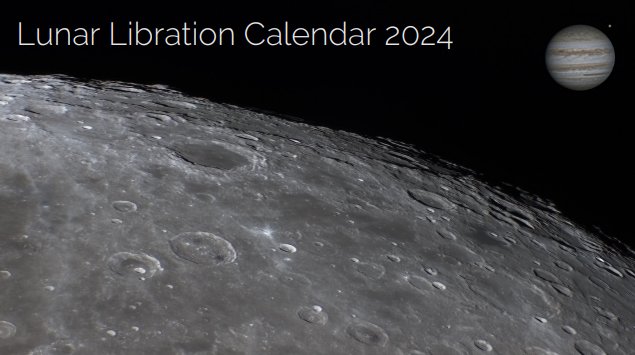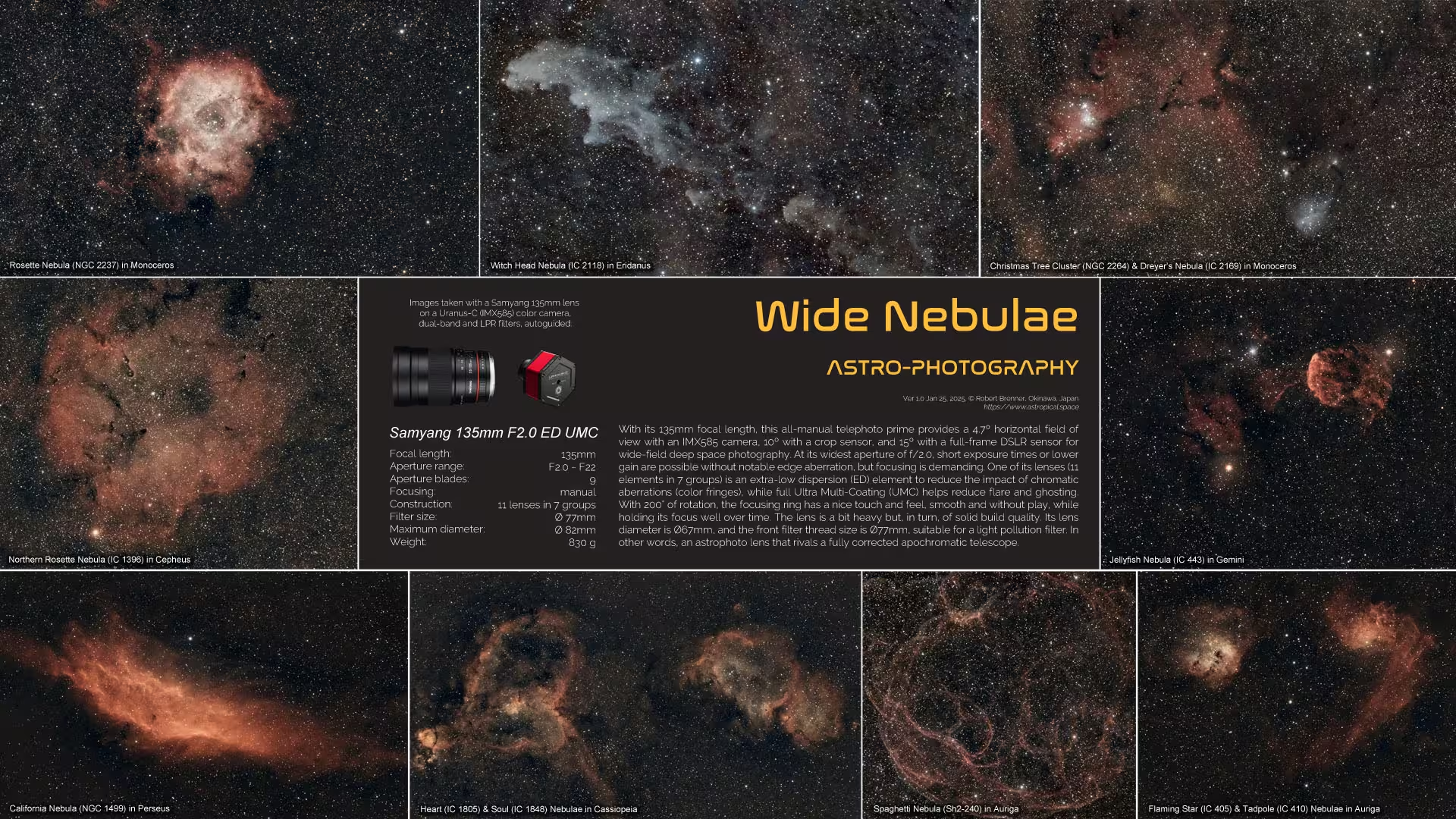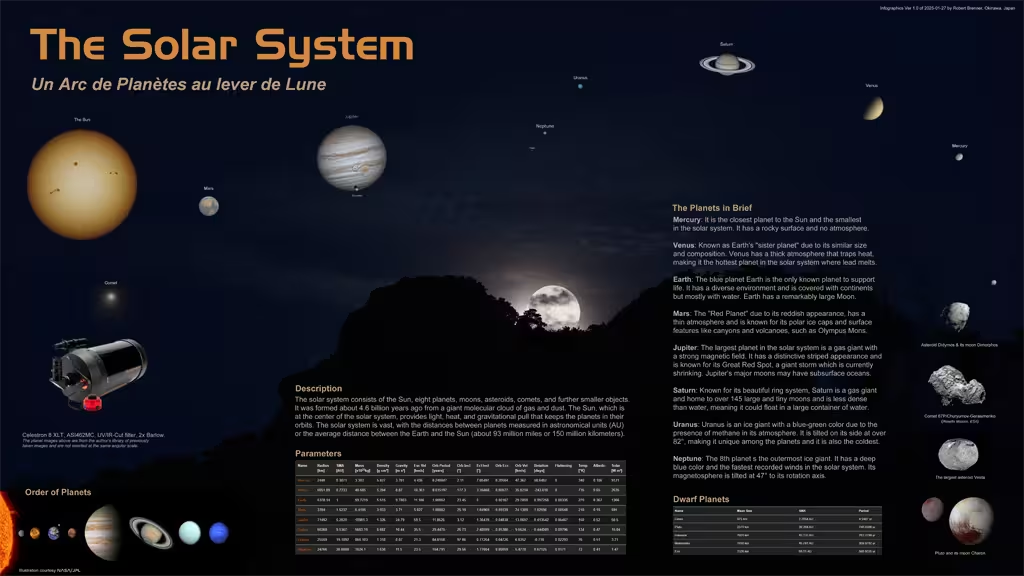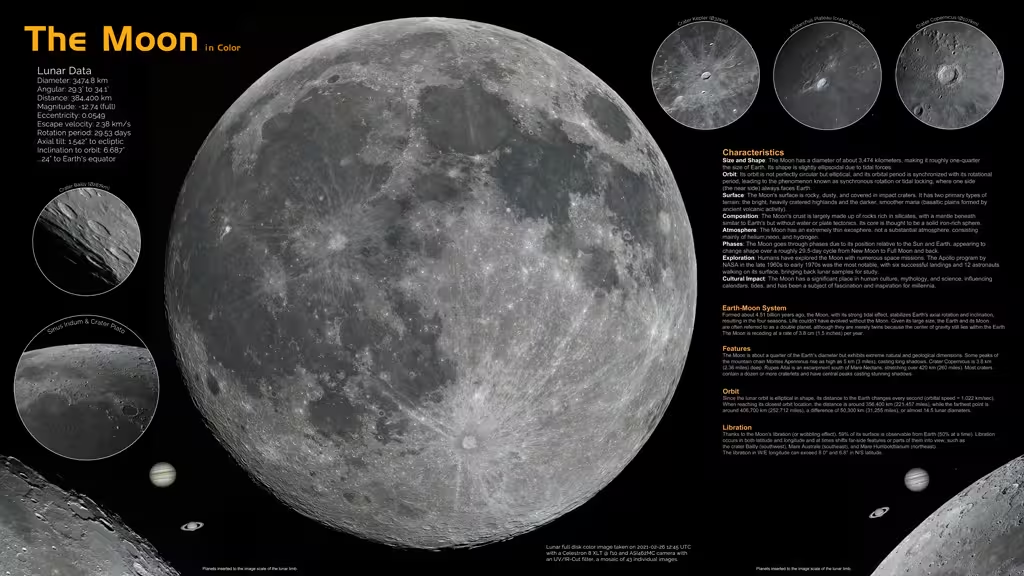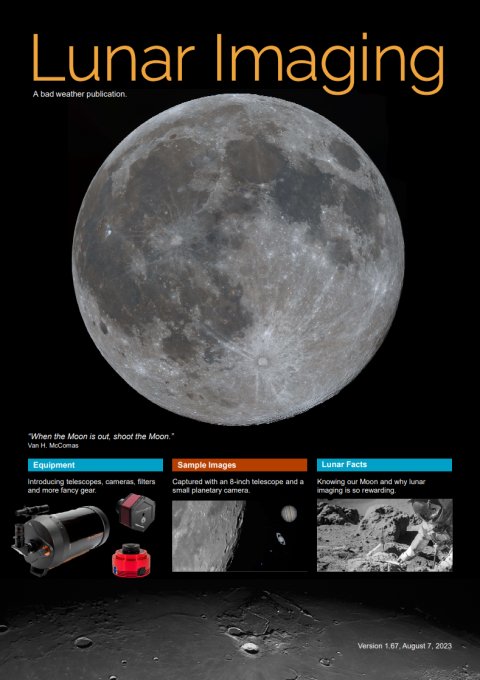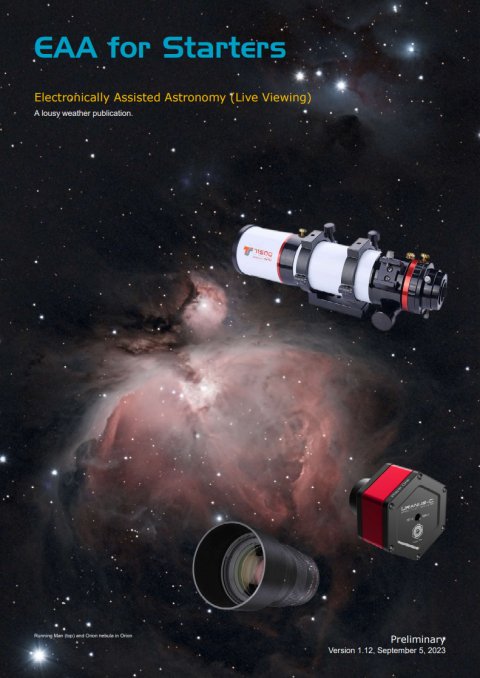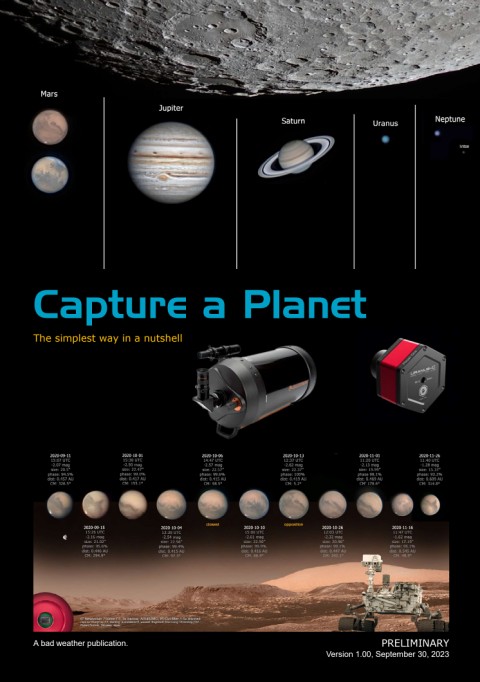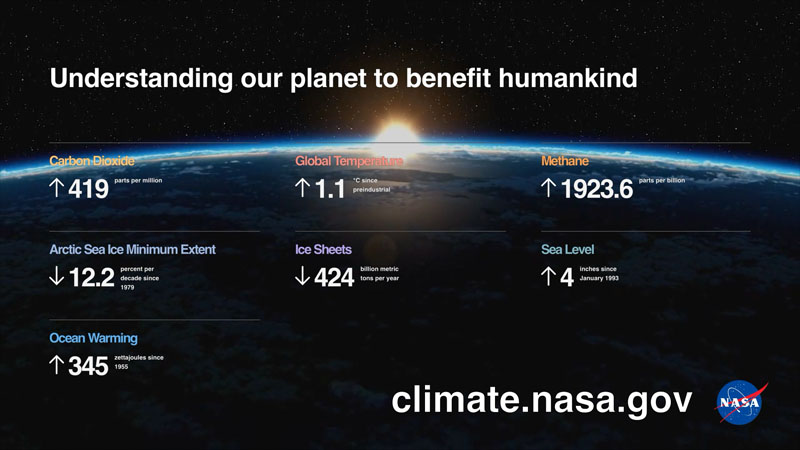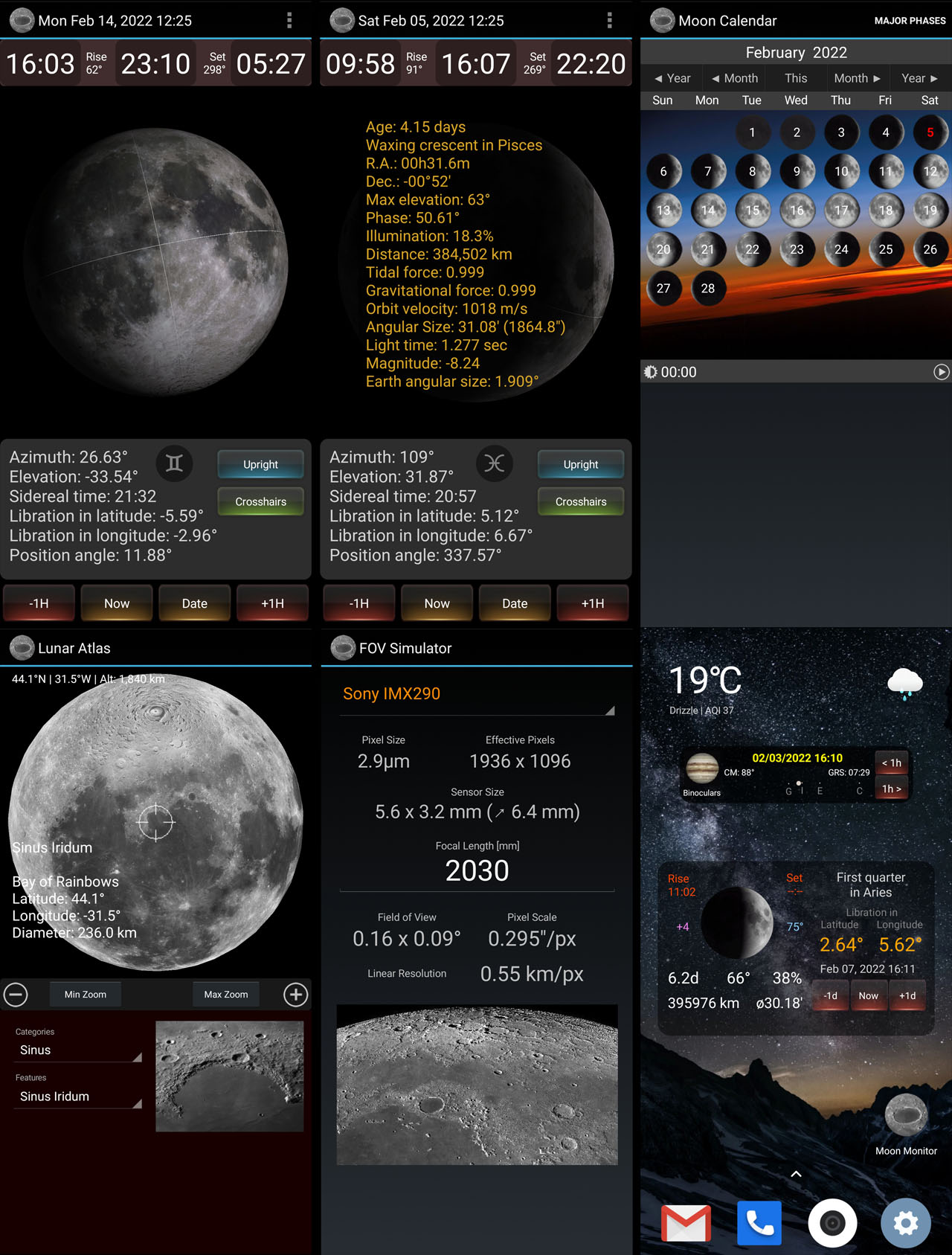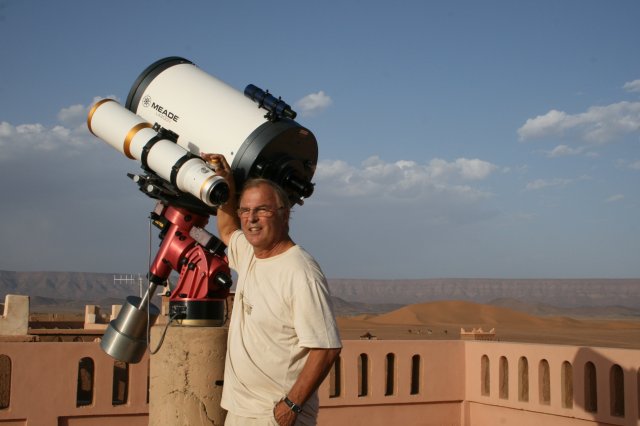Astronomical database with 3D simulations, visualizations, computations, review, articles, and more.
This website is not tailored to smartphones or other hand-held devices.

Sun & Moon Today
Observable comet count is 1199
Current exoplanet count is 5889
Current longitude II of the GRS is 72°
Warning: stripos(): Offset not contained in string in /home3/requio/public_html/index.php on line 297
Impact Probablity of 2024 YR4: Insignificant
| Asteroid | Size | Probability | Date |
| 2024 YR4 | 40—90 m | Insignificant | 22 December 2032 |
Please do not let this worry you. The asteroid has been detected just recently meaning that the orbital elements are not yet accurately determined, while they can alter any time due to gravitational pulls.

The risk corridor of 2024 YR4's possible impact locations runs from the Pacific Ocean to Northern South America, the Atlantic Ocean, central Africa, a corner of the Arabian peninsula, and then to northern India (Source Wikipedia).
Today Monitor
Planet Oppositions
Mars: January 16, 2025
Jupiter: January 10, 2026
Saturn: September 21, 2025
Uranus: November 21, 2025
Neptune: September 23, 2025
Greatest Elongation of Venus
Evening: January 10, 2025 at 47.2°E
Morning: June 1, 2025 at 45.9°W
Greatest Elongation of Mercury
Morning: December 25, 2024 at 22.0°W
Evening: March 8, 2025 at 18.2°E
Morning: April 21, 2025 at 27.4°W
Evening: July 4, 2025 at 25.9°E
Morning: August 19, 2025 at 18.6°W
Evening: October 29, 2025 at 23.9°E
Morning: December 7, 2025 at 20.7°W
Evening: Febrary 19, 2026 at 18.1°E
Super Moons (full) 2025
Wednesday, 5 November
Friday, 5 December
given for 00:00 UT
In Longitude (negative is western)
| Date | Size | Age | Angle | Phase |
|---|---|---|---|---|
| 23 Feb 2025 | 30.61' | 24.48 | -6.502° |  |
| 24 Feb 2025 | 31.06' | 25.48 | -6.683° |  |
| 25 Feb 2025 | 31.54' | 26.48 | -6.463° |  |
| 22 Mar 2025 | 30.16' | 21.97 | -6.602° |  |
| 23 Mar 2025 | 30.54' | 22.97 | -7.220° |  |
| 24 Mar 2025 | 31.00' | 23.97 | -7.497° |  |
| 25 Mar 2025 | 31.50' | 24.97 | -7.380° |  |
| 26 Mar 2025 | 32.03' | 25.97 | -6.841° |  |
| 04 Apr 2025 | 31.86' | 5.54 | 6.674° |  |
| 05 Apr 2025 | 31.40' | 6.54 | 7.159° |  |
| 06 Apr 2025 | 30.97' | 7.54 | 7.233° |  |
| 07 Apr 2025 | 30.58' | 8.54 | 6.935° |  |
| 19 Apr 2025 | 30.14' | 20.54 | -6.609° |  |
| 20 Apr 2025 | 30.49' | 21.54 | -7.247° |  |
| 21 Apr 2025 | 30.91' | 22.54 | -7.602° |  |
| 22 Apr 2025 | 31.38' | 23.54 | -7.618° |  |
| 23 Apr 2025 | 31.89' | 24.54 | -7.248° |  |
| 24 Apr 2025 | 32.39' | 25.54 | -6.459° |  |
| 02 May 2025 | 32.05' | 4.19 | 6.908° |  |
| 03 May 2025 | 31.53' | 5.19 | 7.524° |  |
| 04 May 2025 | 31.04' | 6.19 | 7.652° |  |
| 05 May 2025 | 30.59' | 7.19 | 7.335° |  |
| 06 May 2025 | 30.21' | 8.19 | 6.642° |  |
| 18 May 2025 | 30.56' | 20.19 | -6.624° |  |
| 19 May 2025 | 30.92' | 21.19 | -6.950° |  |
| 20 May 2025 | 31.32' | 22.19 | -7.010° |  |
| 21 May 2025 | 31.75' | 23.19 | -6.758° |  |
| 30 May 2025 | 32.13' | 2.87 | 6.436° |  |
| 31 May 2025 | 31.63' | 3.87 | 7.137° |  |
| 01 Jun 2025 | 31.12' | 4.87 | 7.336° |  |
| 02 Jun 2025 | 30.65' | 5.87 | 7.064° |  |
| 29 Jun 2025 | 31.11' | 3.56 | 6.528° |  |
| 02 Oct 2025 | 30.80' | 10.17 | -6.602° |  |
| 03 Oct 2025 | 31.28' | 11.17 | -6.712° |  |
| 04 Oct 2025 | 31.79' | 12.17 | -6.413° |  |
| 13 Oct 2025 | 32.01' | 21.17 | 6.426° |  |
| 14 Oct 2025 | 31.60' | 22.17 | 7.017° |  |
| 15 Oct 2025 | 31.20' | 23.17 | 7.219° |  |
| 16 Oct 2025 | 30.83' | 24.17 | 7.068° |  |
| 17 Oct 2025 | 30.51' | 25.17 | 6.617° |  |
| 29 Oct 2025 | 30.28' | 7.48 | -6.622° |  |
| 30 Oct 2025 | 30.70' | 8.48 | -7.213° |  |
| 31 Oct 2025 | 31.18' | 9.48 | -7.461° |  |
| 01 Nov 2025 | 31.71' | 10.48 | -7.298° |  |
| 02 Nov 2025 | 32.24' | 11.48 | -6.672° |  |
| 10 Nov 2025 | 32.23' | 19.48 | 7.097° |  |
| 11 Nov 2025 | 31.72' | 20.48 | 7.804° |  |
| 12 Nov 2025 | 31.23' | 21.48 | 8.024° |  |
| 13 Nov 2025 | 30.78' | 22.48 | 7.808° |  |
| 14 Nov 2025 | 30.39' | 23.48 | 7.230° |  |
| 26 Nov 2025 | 30.27' | 5.72 | -6.459° |  |
| 27 Nov 2025 | 30.63' | 6.72 | -7.095° |  |
| 28 Nov 2025 | 31.05' | 7.72 | -7.447° |  |
| 29 Nov 2025 | 31.52' | 8.72 | -7.439° |  |
| 30 Nov 2025 | 32.02' | 9.72 | -7.008° |  |
| 08 Dec 2025 | 32.44' | 17.72 | 6.680° |  |
| 09 Dec 2025 | 31.91' | 18.72 | 7.561° |  |
| 10 Dec 2025 | 31.38' | 19.72 | 7.916° |  |
| 11 Dec 2025 | 30.87' | 20.72 | 7.788° |  |
| 12 Dec 2025 | 30.43' | 21.72 | 7.247° |  |
| 26 Dec 2025 | 31.06' | 5.93 | -6.615° |  |
| 27 Dec 2025 | 31.43' | 6.93 | -6.624° |  |
In Latitude (negative is southern)
| Date | Size | Age | Angle | Phase |
|---|---|---|---|---|
| 12 Jan 2025 | 31.85' | 12.07 | -6.565° |  |
| 13 Jan 2025 | 31.60' | 13.07 | -6.448° |  |
| 26 Jan 2025 | 30.57' | 26.07 | 6.621° |  |
| 27 Jan 2025 | 30.96' | 27.07 | 6.622° |  |
| 08 Feb 2025 | 31.60' | 9.48 | -6.682° |  |
| 09 Feb 2025 | 31.36' | 10.48 | -6.624° |  |
| 22 Feb 2025 | 30.21' | 23.48 | 6.703° |  |
| 23 Feb 2025 | 30.61' | 24.48 | 6.800° |  |
| 24 Feb 2025 | 31.06' | 25.48 | 6.559° |  |
| 07 Mar 2025 | 31.74' | 6.97 | -6.762° |  |
| 08 Mar 2025 | 31.39' | 7.97 | -6.766° |  |
| 09 Mar 2025 | 31.05' | 8.97 | -6.404° |  |
| 21 Mar 2025 | 29.85' | 20.97 | 6.665° |  |
| 22 Mar 2025 | 30.16' | 21.97 | 6.852° |  |
| 23 Mar 2025 | 30.54' | 22.97 | 6.721° |  |
| 03 Apr 2025 | 32.33' | 4.54 | -6.682° |  |
| 04 Apr 2025 | 31.86' | 5.54 | -6.784° |  |
| 05 Apr 2025 | 31.40' | 6.54 | -6.493° |  |
| 17 Apr 2025 | 29.65' | 18.54 | 6.506° |  |
| 18 Apr 2025 | 29.86' | 19.54 | 6.754° |  |
| 19 Apr 2025 | 30.14' | 20.54 | 6.698° |  |
| 30 Apr 2025 | 32.98' | 2.19 | -6.438° |  |
| 01 May 2025 | 32.55' | 3.19 | -6.675° |  |
| 02 May 2025 | 32.05' | 4.19 | -6.485° |  |
| 15 May 2025 | 29.78' | 17.19 | 6.605° |  |
| 16 May 2025 | 29.99' | 18.19 | 6.587° |  |
| 28 May 2025 | 32.97' | 0.87 | -6.528° |  |
| 29 May 2025 | 32.60' | 1.87 | -6.460° |  |
| 11 Jun 2025 | 29.82' | 14.87 | 6.526° |  |
| 12 Jun 2025 | 30.02' | 15.87 | 6.530° |  |
| 24 Jun 2025 | 32.85' | 27.87 | -6.457° |  |
| 25 Jun 2025 | 32.68' | 28.87 | -6.502° |  |
| 08 Jul 2025 | 29.84' | 12.56 | 6.561° |  |
| 09 Jul 2025 | 30.07' | 13.56 | 6.600° |  |
| 21 Jul 2025 | 32.45' | 25.56 | -6.493° |  |
| 22 Jul 2025 | 32.38' | 26.56 | -6.624° |  |
| 04 Aug 2025 | 29.76' | 10.20 | 6.646° |  |
| 05 Aug 2025 | 29.99' | 11.20 | 6.748° |  |
| 06 Aug 2025 | 30.28' | 12.20 | 6.541° |  |
| 17 Aug 2025 | 32.23' | 23.20 | -6.553° |  |
| 18 Aug 2025 | 32.11' | 24.20 | -6.755° |  |
| 19 Aug 2025 | 31.94' | 25.20 | -6.550° |  |
| 31 Aug 2025 | 29.61' | 7.75 | 6.661° |  |
| 01 Sep 2025 | 29.78' | 8.75 | 6.848° |  |
| 02 Sep 2025 | 30.05' | 9.75 | 6.733° |  |
| 13 Sep 2025 | 32.46' | 20.75 | -6.508° |  |
| 14 Sep 2025 | 32.22' | 21.75 | -6.794° |  |
| 15 Sep 2025 | 31.95' | 22.75 | -6.665° |  |
| 27 Sep 2025 | 29.47' | 5.17 | 6.540° |  |
| 28 Sep 2025 | 29.56' | 6.17 | 6.805° |  |
| 29 Sep 2025 | 29.74' | 7.17 | 6.779° |  |
| 30 Sep 2025 | 30.01' | 8.17 | 6.453° |  |
| 11 Oct 2025 | 32.77' | 19.17 | -6.687° |  |
| 12 Oct 2025 | 32.41' | 20.17 | -6.652° |  |
| 25 Oct 2025 | 29.42' | 3.48 | 6.651° |  |
| 26 Oct 2025 | 29.52' | 4.48 | 6.681° |  |
| 27 Oct 2025 | 29.69' | 5.48 | 6.423° |  |
| 07 Nov 2025 | 33.37' | 16.48 | -6.472° |  |
| 08 Nov 2025 | 33.10' | 17.48 | -6.565° |  |
| 21 Nov 2025 | 29.39' | 0.72 | 6.513° |  |
| 22 Nov 2025 | 29.46' | 1.72 | 6.567° |  |
| 05 Dec 2025 | 33.44' | 14.72 | -6.511° |  |
| 18 Dec 2025 | 29.42' | 27.72 | 6.502° |  |
| 19 Dec 2025 | 29.48' | 28.72 | 6.570° |  |
Source: NASA/GSFC
Latest STScI News Release
NASA's Hubble Pinpoints Roaming Massive Black Hole

May 08, 2025
Six-panel illustration marked "Artist's Concept." The upper left panel shows the silhouette of supermassive black that is adrift inside a galaxy. The middle upper panel shows a yellow star drifting near the black hole. The three following panels show the star being shredded in bright white concentric streamers followed by a white explosion. the bottom right panel is an external view of the galaxy showing a bright white star-like object that is the site if the explosion as viewed in X-rays and visible light.
Source: stsci.edu/news
Latest JWST News
Webb uncovers possible hidden supermassive black hole in nearby spiral galaxy M83
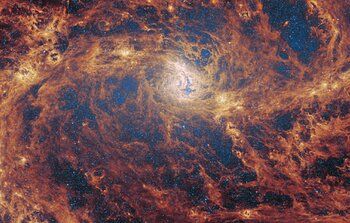
17 April 2025
Astronomers using the NASA/ESA/CSA James Webb Space Telescope have discovered evidence that suggests the presence of a long-sought supermassive black hole at the heart of the nearby spiral galaxy Messier 83 (M83). This surprising finding, made possible by Webb’s Mid-Infrared Instrument (MIRI), reveals highly ionised neon gas that could be a telltale signature of an active galactic nucleus (AGN), a growing black hole at the center of a galaxy.
Source: esawebb.org
JWST Picture of the Month
Infrared, optical, and X-ray views of a galaxy group
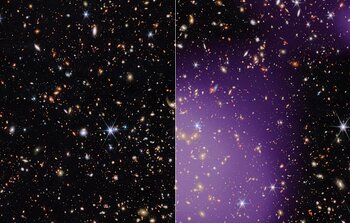
29 April 2025
This new Picture of the Month from the NASA/ESA/CSA James Webb Space Telescope features an astounding number of galaxies. The objects in this frame span an incredible range of distances, from stars within our own Milky Way, marked by diffraction spikes, to galaxies billions of light-years away. The star of this field is a group of galaxies, the largest concentration of which can be found just below the centre of this image. These galaxies glow with white-gold light. We see this galaxy group as it appeared when the Universe was 6.5 billion years old, a little less than half the Universe’s current age. The image on the left combines infrared data from both Webb and the NASA/ESA Hubble Space Telescope, showcasing the galaxy cluster against a backdrop of thousands of other galaxies. The image on the right adds X-ray data from ESA’s XMM-Newton space observatory and NASA’s Chandra X-ray Observatory …
Source: esawebb.org
NASA Image of the Day
NASA Astronaut Anne McClain Works on Space Station
NASA astronaut and Expedition 72 flight engineer Anne McClain is pictured near one of the International Space Station's main solar arrays during a spacewalk to upgrade the orbital outpost's power generation system and relocate a communications antenna.
Click to enlarge or show full screenThu, 08 May 2025 20:15 GMT
Source: www.nasa.gov
Life on Exoplanet K2-18b?
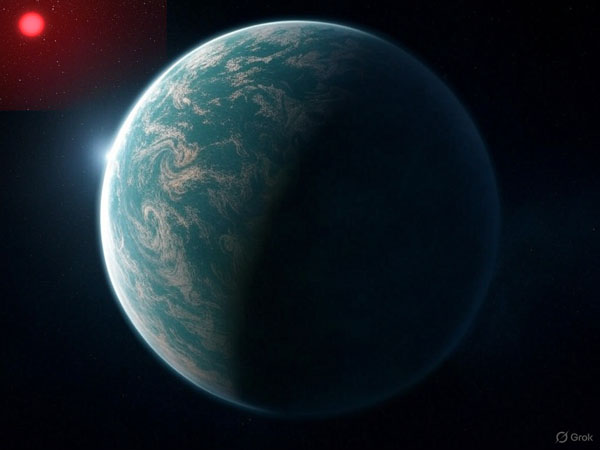
Image credit: Grok (modified with red star)
2025-04-18 Exoplanets
Thanks to NASA's JWST, astronomers have detected signatures of life on the exoplanet K2-18b, 124 light-years away in Leo, which is 2.6 times larger and 8.6 times more massive than the Earth. The planet's atmosphere contains dimethyl sulfide (DMS), naturally produced by living organisms. Already in September 2023 NASA reported that the JWST has revealed the presence of carbon-bearing molecules including methane and carbon dioxide. Link to source 🔗
Direct Images of Gas Giant Planets
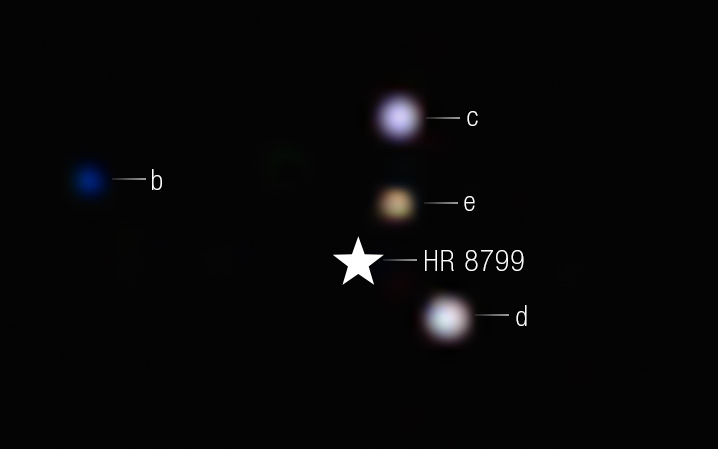
Image credit: NASA, ESA, CSA, STScI, W. Balmer (JHU), L. Pueyo (STScI), M. Perrin (STScI)
2025-03-18 Exoplanets
HR 8799 is a young star with 1.5 solar masses, about 130 light-years away in Pegasus and known to have four giant gas planets rich in carbon dioxide gas. NASA’s James Webb Space Telescope took a spectrum and imaged the four planets while the light of the star has been blocked. Link to source 🔗
Barnard's Four Tiny Planets
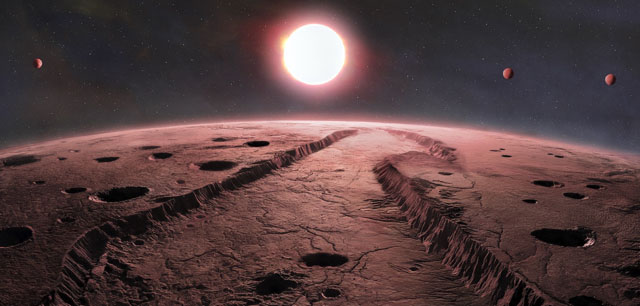
Image credit: International Gemini Observatory/NOIRLab/NSF/AURA/R. Proctor/J. Pollard
2025-03-14 Exoplanets
Next to the Alpha Centauri system, Barnard's star is the second nearest at 5.96 light-years away in Ophiuchus. As of March 2025, the red dwarf star, only 0.16 as massive as the sun, is home to four known (confirmed) planets each of them less than half the mass of Earth and none of them orbiting inside the habitable zone. Only between 2.8 and 4.1 million kilometers away from the star on 2.34 to 6.74 days orbits, their surfaces are supposed to be heat scorched with no outlook for life. Link to source 🔗
Asteroid 2024 YR4
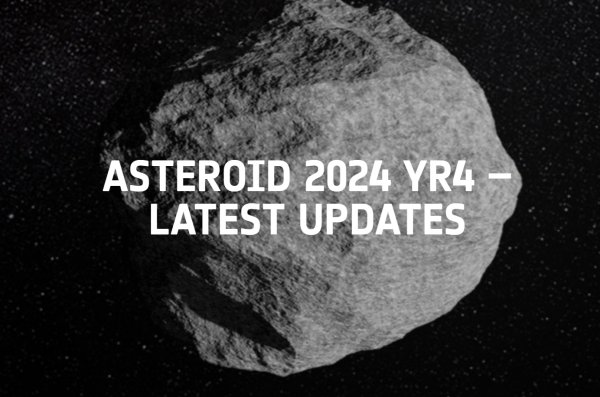
Image credit: European Space Agency
2025-02-07 solar system
2024 YR4 is an extremely faint asteroid with a low albedo of 5% to 25% and is 40 to 90 meters in size which, as of today, has a minute 2.2% probability of impacting Earth at 14:02 UTC on December 22, 2032. The asteroid rotates around its axis every 19.5 minutes and travels around the sun on a highly 0.662 eccentric orbit plane once in about 4 years at a mean distance of 2.5165 AU. Its last perihelion (sun passage) occurred on 2024-Nov-22. The iron-nickel asteroid that created the Barringer Crater in Arizona 50,000 years ago was about 50 meters wide. Link to source 🔗
Nearby Venus-Like Planet
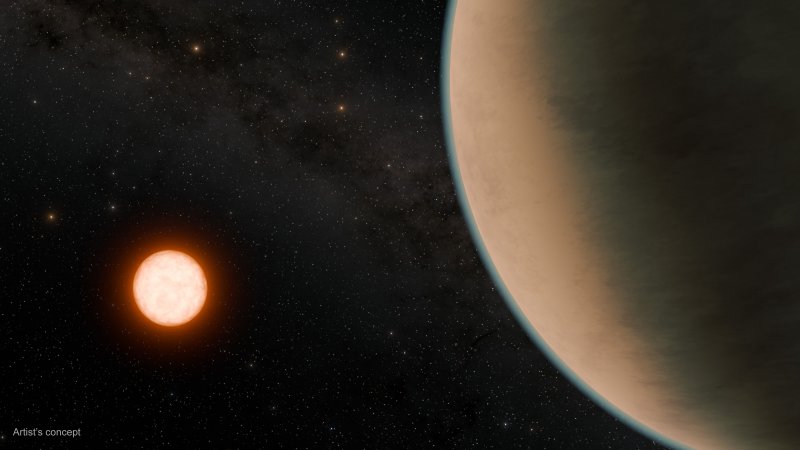
Image credit: NASA/JPL-Caltech/R. Hurt (Caltech-IPAC)
2025-02-01 Exoplanets
Gliese 12 (TOI-6251) is a red dwarf star some 40 light-years away in Pisces. Its known planet, b, about the same size as Venus and, because a red dwarf is much cooler than our sun, the planet also receives the same amount of energy from its host star although orbiting much closer and once in about 12.8 days. In astronomical terms, the planet lies nearby and is a potentially terrestrial, temperate exoplanet inviting further investigations, such as atmospheric spectroscopy with the help of the JWST. Link to source 🔗
New Space Telescope SPHEREx
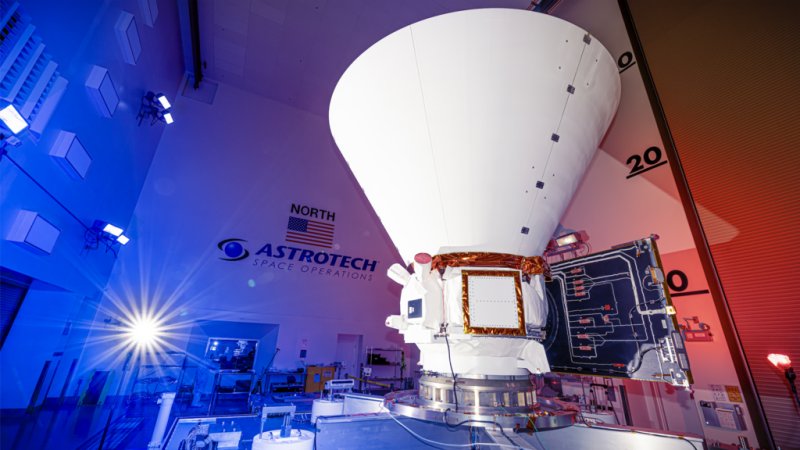
Image credit: NASA/JPL-Caltech
2025-01-31 Universe
Scheduled for launch past February 2025, SPHEREx is NASA's latest orbiting space telescope, designed for a spectral survey of the entire sky for a duration of tentatively two years in order to explore the origins of the universe. Link to source 🔗
Blackhole Binary
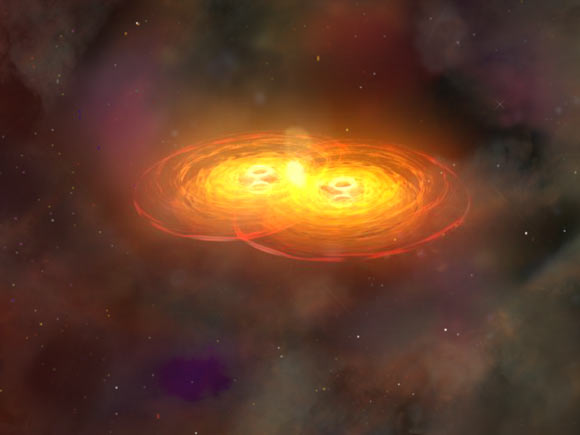
Image credit: NASA / CXC / A. Hobart / Josh Barnes, University of Hawaii / John Hibbard, NRAO
2025-01-20 galaxies
Astronomers at the University of Tokyo discovered a rare quasar-like object with a long-term periodic luminosity variation with a cycle of about 190 days. Two black holes moving periodically at high speed may be the cause of the variability, hypothetically a supermassive blackhole binary. The extremely luminous object lies in the constellation of Hydra and is designated J0909+0002 in short. Link to source 🔗
A new Type of Planet?

Image credit: NAOJ
2025-01-15 Exoplanets
Using the James Webb Space Telescope, astronomers scanned the atmosphere of the planet GJ1214 b located 48 light-years away in Ophiuchus. Instead of a hydrogen rich super-Earth, or a water world, the new data, in spite of many uncertainties, revealed concentrations of carbon-dioxide (CO2) comparable to the levels found in the dense CO2 atmosphere of Venus. Link to source 🔗
Backlog
No, we are not on Facebook but proudly on AstroBin with Mille Gracie to the author Salvatore Iovene:

GoTo Astropical on AstroBin
If anybody is interested in the night life of bats, here is a funny 1-minute MP4 video (24MB).
Recent
1. Certain people appear to enjoy filling forms with random letters for no purpose but insane self-satisfaction. Most of this stupid folks leave their IP addresses which are forwarded to their provider companies. All so received forms are automatically deleted. Sadly, the world is overfilled with idiots, trolls and criminals. This is a public web site without any sensitive data. No need for these irrational displays.
2. Now in the process of changing all large images to AVIF or WEBP format resulting in considerably reduced file size and download time hardly sacrificing quality as compared with JPEG.
Legal
In case of abuse or hacking attempts, we reserve the right to report to providers, ISPs and legal authorities. The contents of this site is public, no hidden secrets. The data is backed up in regular intervals.
Cookies
This website does NOT send and use "cookies".
Privacy
Your visit is anonymous. The author processes merely the data that a web browser is typically sending back. The only purpose is for the [Visitors Online] section below.
Free Registration
In order for location dependent data to show correctly you need to register. In the interest of your privacy this website does not automatically retrieve your location via third party services, etc.
Compatibility
Website tested under Windows and Android only. Although largely compatible with smartphones this website is primarily designed for desktops, note books and tablets. This applies in particular to database tables. Double click on page top banners to remove them.
Monitor Calibration
Please adjust your monitor's gamma and contrast, etc. if you cannot distinguish all shades of gray. Click for an enlarged color pattern.

URL Request
If you do not wish to register (no problem) but need to see data for your location only once or so, then you can add the following string to the URL:
?lat=xx.xxx&lon=xxx.xxx&tzn=z.zz
where xx.xxx need to be replaced by your geographic coordinates, z.zz with your time zone. This data will not be stored.
This 'once-view' will work for most pages, such as Planisphere, Deepsky Observer, Ephemerides and Today Monitor.
 US, Arizona, Phoenix
US, Arizona, PhoenixLast visit from: CN

on page deepsky.php using iPhone O/S.
Unique visitors today: 28 (since 0:00 UTC) from:









Newest flag:  Thailand -- Welcome!
Thailand -- Welcome!
Total page views 2216 since 2025-05-01
from 74 different countries (excluding bots & idiots).









































































Operating SystemsMacintosh: 1066Windows: 486 iPhone: 413 Android: 143 Linux: 82 iPad: 17 Unknown: 5 Other: 4 |
Most Visitedindex.php: 1415algol.php: 82 apscopes.php: 76 nikond5300.php: 48 crafts.php: 37 hipparcos.php: 35 php_calendar.php: 26 starref.php: 23 exoplnt.php: 23 kyoei.php: 21 |
Site Updates
- 2025-03-30 • Astro Weather added (middle column)
- 2025-03-29 • Article reviewed & updated.
- 2025-02-23 • Exoplanet single page fixed.
- 2025-02-17 • ISS Live Cameras fixed.
- 2025-02-17 • Orion Atlas EQ-G Hints added
- 2025-02-16 • EG6-R Pro Mount Review added
- 2025-02-07 • Mounts for AP added
- 2025-01-25 • New Deepsky Poster added
- 2025-01-25 • Lunar Posters added
- 2025-01-20 • Mini Posters added
- 2025-01-02 • Planet ephemerides updated
- 2025-01-01 • Libration calendar updated
- 2024-10-07 • Various minor changes and code fixes
- 2024-10-07 • Aladin removed as not own work
- 2024-05-14 • JWST Images added to Top Page
- 2024-01-09 • Exoplanets with PHL/HWC
- 2023-12-27 • Tomytec Borg telescopes added.
- 2023-12-23 • Takahashi telescopes added.
- 2023-12-21 • Asteroid Dinkinesh & Didymos added.
- 2023-12-18 • Telescopes for AP updated
- 2023-12-02 • Libration calendar 2024 uploaded
- 2023-12-01 • Ephemeris updated for 2024
- 2023-11-16 • Libration data for 2024 updated
- 2023-11-14 • Review BKP150 updated
- 2023-11-13 • Review TS71SDQ updated
- 2023-09-18 • Page Optical Train added
- 2023-10-21 • New PDF brochure added
- 2023-09-18 • Review: Uranus-C added
- 2023-01-21 • EAA for Starters PDF added

Deepsky Overview
My Humble Gallery
Lunar Imaging
FOV Simulator
Astro Cameras

Let's Astrophoto
Telescopes for AP
Total Exoplanet Count: 5889
Kepler/K2: 3328 planetsTESS: 622 planets
Latest exoplanet around:
as of 2025-04-29
| Constellation | Libra |
| Mass | 0.033104 xSun |
| Known planet(s) | 1 |
Acton Sky Portal Observatory 2
Anglo-Australian Telescope 35
Apache Point Observatory 2
Arecibo Observatory 3
Atacama Large Millimeter Array (ALMA) 1
Bohyunsan Optical Astronomical Observatory 26
Calar Alto Observatory 26
Cerro Tololo Inter-American Observatory 5
CHaracterising ExOPlanets Satellite (CHEOPS) 3
CoRoT 35
European Southern Observatory 4
European Space Agency (ESA) Gaia Satellite 13
Fred Lawrence Whipple Observatory 6
Gemini Observatory 13
Haleakala Observatory 2
HATNet 67
HATSouth 73
Haute-Provence Observatory 67
Hubble Space Telescope 6
Infrared Survey Facility 1
James Webb Space Telescope (JWST) 1
K2 547
KELT 10
KELT-North 7
KELT-South 4
Kepler 2781
Kitt Peak National Observatory 1
KMTNet 103
KOINet 1
La Silla Observatory 286
Large Binocular Telescope Observatory 3
Las Campanas Observatory 29
Leoncito Astronomical Complex 1
Lick Observatory 36
Lowell Observatory 3
Mauna Kea Observatory 3
McDonald Observatory 31
MEarth Project 2
MOA 31
Multiple Facilities 18
Multiple Observatories 326
NASA Infrared Telescope Facility (IRTF) 1
Next-Generation Transit Survey (NGTS) 21
OGLE 106
Okayama Astrophysical Observatory 36
Palomar Observatory 2
Paranal Observatory 30
Parkes Observatory 2
Qatar 10
Roque de los Muchachos Observatory 35
South African Radio Astronomy Observatory (SAR 1
SPECULOOS Southern Observatory 2
Spitzer Space Telescope 4
Subaru Telescope 11
SuperWASP 122
SuperWASP-North 5
SuperWASP-South 32
Teide Observatory 1
Thueringer Landessternwarte Tautenburg 8
Transiting Exoplanet Survey Satellite (TESS) 622
TrES 5
United Kingdom Infrared Telescope 2
University of Canterbury Mt John Observatory 1
Very Long Baseline Array 1
W. M. Keck Observatory 189
WASP-South 11
Wide-field Infrared Survey Explorer (WISE) Sat 1
Winer Observatory 1
Xinglong Station 2
XO 6
Yunnan Astronomical Observatory 3
Zwicky Transient Facility 2
Next NEO Approach
2025 JK1 on 2025-May-10 05:29 UTC at 3.2333 LD
Random Objects
Chara (8 Bet CVn) in CVn [HIP 61317]
Distance: 27 light-years, Magnitude: 4.24
Chara (Greek for joy), also called Asterion, is a class-G main sequence star very much resembling the sun though slightly larger, somewhat younger and with a smaller portion of heavy elements. Additionally, Beta CVn is a single star, and no large planets have so far been found orbiting it.
Star Chart | DSS IR Image 🔗GJ 244 A (Sirius A ) in Canis Major
Distance: 9 light-years, Magnitude: -1.4
Dominating the early year sky, Sirius, the 'Dog Star', in Canis Major is the brightest star in the sky. Measuring 2.02 solar masses, 1.7 solar radii and outshining the sun 25 times, Sirius exhibits a metal-rich spectrum. It has a faint white dwarf companion and is 200-300 million years old. The distance separating Sirius A from its companion varies between 8.2 and 31.5 AU. The companion, Sirius B, is the first detected White Dwarf star.
Star Chart | DSS IR Image 🔗

M54 (Globular Cluster) in Sagittarius
Magnitude: 7.6
Running away from us at a speed of 142 km/s, this compact globe of stars could be as wide as 150 light-years in diameter and as far away as 87,400 light years which is beyond our own Milky Way Galaxy.
Star Chart | DSS IR Image 🔗Andromeda (northern), area rank: 19

Formed of stars spreading out from one of the stars in the Pegasus Square, this constellation is home to our neighbor, the Andromeda Galaxy, over 2.3 million light-years away. In dark skies the galaxy can be seen with the unaided eye. Viewed with binoculars it appears like a glowing cloud.
Star Chart2P/Encke

Discovered in 1786, comet 2P/Encke is a short-period comet with the shortest known period of 3.3 years and nucleus 4.8 km wide. Encke's orbit is moderately inclined to the ecliptic (12°) in that the comet is often perturbed by the inner planets, rendering its orbit unstable. Encke can get as close as 26 million km to Earth. Such approaches occur about every 33 years. The last perihelion occurred on November 21st 2013. On Nov. 18th 2013, comet Encke passed within 0.025 AU of Mercury, followed a day later by Comet C/2012 S1 (ISON) at 0.24 AU.
Pulcova (Asteroid)
Semi-major: 3.16347 AU, Size: 137 km
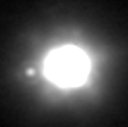
Discovered by Grigoriy N. Neujmin in 1913, 762 Pulcova is a C-type main belt asteroid with low orbital eccentricity, dark and with a carbonate composition. Pulcova rotates around its axis in 5.839 hours and has a mass of 1.4x1018kg. Its density below that of water (0.9g/cm³) suggests that Pulcova may be a loosely-packed rubble pile, rather than a monolithic object. On January 22, 2000, a 15 km wide satellite, designated S/2000 (762) 1, was detected at the Canada-France-Hawaii Telescope on Mauna Kea. It orbits at a mean distance of about 800 km with a period of 4 days.
Ariel (moon of Uranus)
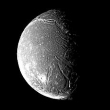
Discovered in 1851, Ariel's surface appears to be the youngest and brightest of all the moons of Uranus. It has few large craters and many small ones and is transected by grabens, which are fault-bounded valleys. Ariel consist mostly of roughly equal amounts of water ice and silicate rock. Carbon dioxide has also been detected.
TOI-481 b (in Carina)
Mass: 1.53 xJup
Radius: 0.99 xJup
SMA: 0.097 AU
Period: 10.3311 days
Distance: 179.366 parsec
Category: Hot Jovian
ESI: 0.08
Android Astronomy Apps
3D Visualizations
Solar System
Planets
Mercury | Venus | Venus Radar | Earth | Earth Melted | Earth Cretaceous | Mars | Mars Terraformed | Jupiter | Saturn | Uranus | Neptune | Planet Nine (hypothetical)Dwarf Planets
Ceres | Pluto | Haumea | Makemake | Eris | KBOAsteroids
Vesta | Pallas (fictive) | Juno (fictive) |Planetary Moons
Ariel (Uranus) | Callisto (Jupiter) | Charon (Pluto) | Dione (Saturn) | Enceladus (Saturn) | Europa (Jupiter) | Ganymede (Jupiter) | Iapetus (Saturn) | Io (Jupiter) | Mimas (Saturn) | Miranda (Uranus) | Moon (Earth) | Oberon (Uranus) | Rhea (Saturn) | Tethys (Saturn) | Titan (Saturn) | Titania (Uranus) | Triton (Neptune) | Umbriel (Uranus)Comets
67P/Churyumov-Gerasimenko (takes a minute to download)Exoplanets
Exoplanets
Rocky Terran | Ocean Terran | Hot Terran | Warm Terran | Desert Terran | Water Terran | Second Earth | Cloud Planet | Jovian Planet | Saturnian PlanetEarth
Beautiful Earth
Earth in hi-res (can take a minute to download)Earth at Night
Panoramic view (can take a minute to download)
